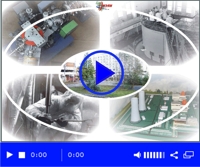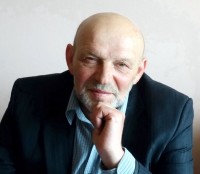Laboratory of Radiation and Chemical Studies of the Environment # 05
Michail ZHEMZHUROV, D.Sc. in Engineering Sciences
E-mail: jema@sosny.bas-net.by
Tel.: +375 (17) 374-94-67
Fax: +375 (17) 374-83-35
History
The Laboratory was founded in 1986 by corresponding member of NAS of Belarus V. Nesterenko to develop nuclear-physical methods of diagnostics of the coolant fluids and the cores of nuclear reactors. Then research in the lab has been reoriented to develop methods of decontamination a radioactive waste. Heads of laboratories have been a corresponding member of the NAS of Belarus V. Nesterenko, then Ph.D. G. Petukhov, Ph.D. A. Gvozdev. Currently, the laboratory headed by Dr. M. Zhemzhurov.
The area of research:
- development of methods for rehabilitation of the environment contaminated with radioactive wastes, scientific foundations of environmental measures, methodology, safety analysis of near-surface disposal facilities of radioactive waste, strategy for radioactive waste disposal;
- study patterns of migration of radioactive contaminants from local and area sources;
- development and improvement of methods to determine the content of radionuclides in the environment
- development of nuclear-physical methods of diagnostics of the nuclear reactor core.
Laboratory is accredited by the Belarusian State Accreditation center for technical competence in accordance with the requirements of STB ISO / IEC 17025-2007 (accreditation certificate № BY/112 02.2.0.0464 to 07.05.2015) for measuring the specific activity of radionuclides in water samples, soil, vegetation, food, biological objects, sediment, construction materials, wood, measuring the exposure dose of photon radiation and the flux density of beta-particles of contaminated surfaces, measurements of volumetric activity of natural radon in the air of residential and industrial premises. The laboratory is licensed by the Department on problems of the consequences of the Chernobyl accident Ministry of Emergency of Belarus number 0480/0197213 to carry out activities related to the control of radioactive pollution.
The projects:
- development of nuclear-physical methods of diagnostics of the nuclear fuel in case of refueling of the reactor;
- development of predictive models for calculating the radiation situation on the ground in various emergency situations involving radioactive materials;
- study the influence of fine particles on the sorption and migration ability of radionuclides in the soil;
- survey of storage facilities of radioactive wastes in the former Soviet deployment of military units, assess their safety and to develop recommendations to ensure the safety and rehabilitation of these facilities;
- development of equipment for purifying radioactive wastes, based of the centrifugal vortex chamber of steam generator;
- improving operational and classification system of radioactive waste at nuclear power plants;
- development of basic technologies and design solutions to create a new national facility of disposal of radioactive waste;
- development of basic technologies and design solutions for the reconstruction of the national facility “Ecores” for radioactive waste disposal.
Major achievements:
- developed the concept of environmentally oriented disposal of radioactive waste of Chernobyl origin, whose main provisions are implemented in practice, the organization works to isolate the waste in engineering equipment, radiation control and monitoring of 92 items landfill decontamination carried out a detailed survey of them and proposed a classification, which is now generally accepted;
- revealed differences in the mobility of radionuclides, depending on the form and storage conditions, obtained experimental data characterizing the migration of the waste and protective barriers to set up a surveillance system for the migration of radionuclides from the disposal facilities, studied the dynamics of migration of radionuclides from disposal facilities into the groundwater;

- developed methodology of safety analysis of storages of radioactive wastes disposal, in particular the proposed schematic diagram of a wide range of accounting planned and emergency situations in the safety assessments were developed and validated by the results of experimental measurements of the calculation models of radionuclide migration in groundwater (see, for example, “Reports of the National Academy of Sciences, Volume 47 number 5, 2003., p.115-118; IFJ, tom76 № 6, 2003. with. 146-150);

- developed methods for radionuclides disposal and decontamination of waste in the contaminated areas, developed relevant state regulatory and methodological framework based on methodological and technological solutions;
- studied the state and developed security recommendations for national radioactive wastes facility “Ecores” in the village Sosny, Minsk, which are the base for suggested concept of reconstruction of the object, developed the core technologies of RW and air conditioning (including technology of unloading waste from the “old” repositories for their relocation.) The technological part of the reconstruction of the object, which is performed within the Public Investment Programme of the Republic of Belarus;

- detailed radoecological survey of the “military” items storage of radioactive sources in the field of the dislocation of the former missile with nuclear warheads has been studied. Recommendations are designed and implemented to ensure their safety. Using the survey results, it was decided to eliminate RWDP “Kolosovo” and “Gomel-30.” Currently RWDP “Kolosovo” are liquidated, RWDP “Gomel-30” are processed for liquidation;

- performed scientific substantiation and proposed design solutions for the decontamination of contaminated with uranium ore areas in the city of Brest and disposal of wastes, according to the developed project to clean up contaminated with uranium ore areas in the city of Brest and disposal of radioactive wastes;
- developed a conceptual design of a new national facility of radioactive waste disposal. Based on analysis of the regulatory framework, conceptual approaches and design solutions for nuclear power plants on RWDP developed the basic requirements for RW processing system at the plant. The fundamental technological scheme developed systems for radioactive waste management site and in the ACT, as well as the common principles of design decisions on these systems to enable work on nuclear waste management and open source software into a single process with the ultimate goal – the safe disposal of radioactive waste in the Republicof Belarus. A series of technical codes of practice in the field of radioactive waste. In cooperation with laboratory 03 developed a draft “Strategy for Radioactive Waste Management in the Republicof Belarus”.
- The results are a scientific basis for developing national policies for radioactive waste management, creating a state regulatory framework. They are used by the MOE, the Ministry of Energy, the Ministry of Health, the Ministry of Environment, planning organizations.
Directions for further research:
- It is planned to develop methods for radiation-technological control of nuclear fuel in process of reloading of the reactor, based on measuring spectrum of characteristic gamma radiation of irradiated nuclear fuel. Measuring system, based on simulation, will be proposed for determining the degree of combustion of fuel and control fuel cladding integrity during recovery (transfer) of fuel assemblies from the reactor core.
- It is planned to use methods of sensitivity increasing, reliability of control tightness cladding (CLC) and the localization of defective fuel rods in the core, which are developed at laboratory, at Belarusian nuclear power plant.









